

What's New!
Detailed Sitemap
All images © by Roberto Piperno, owner of the domain. Write to romapip@quipo.it. Text edited by Rosamie Moore.
Page added in November 2013.
|

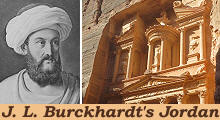 - Jerash - Jerash
(left: J. L. Burckhardt in Arab attire in a XIXth century engraving; right: the Treasury of Petra)
If you came to this page directly you might wish to read an introductory page to this section first.
May 2nd, 1812 - In an hour and a half from Souf we reached the city walls of Djerash (ancient Gerasa). The ruins are nearly an hour and a quarter in circumference, following insulated fragments of the walls, which were upwards of eight feet in thickness, and built of square hewn stones of middling size; I could not judge of their original heighth, as the upper parts were every where demolished.
J. L. Burckhardt - Travels in Syria and the Holy Land - 1822
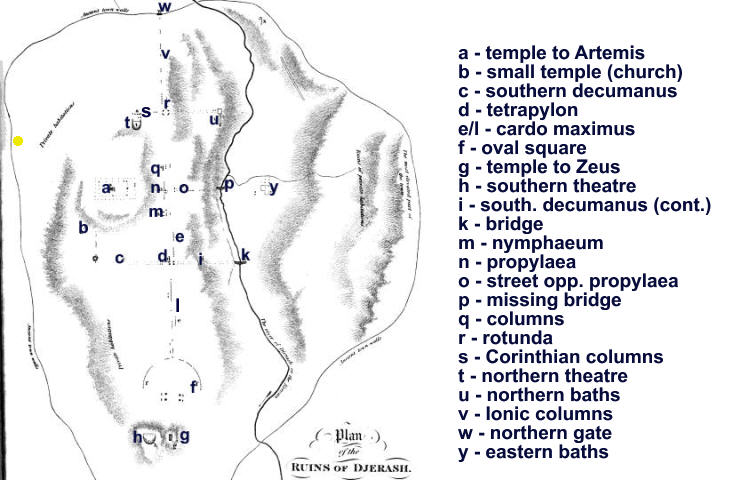
Plan of Jerash drawn by Burckhardt. The yellow dot indicates the point where he entered the town from Souf. The legend is clickable: a to h are covered in this page; i to y in page two
I shall now enumerate the principal curiosities of Djerash, agreeably to the annexed plan, which may give a general idea of the whole; for its accuracy in regard to distances I do not mean to vouch, as I had, at most, only four hours to make my survey, and it was with great difficulty that I could persuade my three companions to wait so long for me. None of them would accompany me through the ruins, on account of their fear of the Bedouins, who are in the habit of visiting this Wady, they therefore concealed themselves beneath the trees that overshade the river.
In general the monuments and streets of Jerash date late Ist century AD or IInd century AD. The town was not part of the Nabatean Kingdom which had its capital at Bosra in Syria. Jerash was a member of Decapolis, a loose federation of ten towns to which the Romans granted some degree of self-government. It included Damascus and Canatha (Qanawat) in Syria, Scythopolis (Bet She'an) in Israel, Pella, Gadara (Umm Qays), Philadelphia (Amman) and some minor towns in Jordan.
Temple to Artemis - a in the plan
The first object that strikes the attention in coming from Souf, after passing the town-wall, is a temple (a). Its main body consists of an oblong square, the interior of which is about twenty-five paces in length, and eighteen in breadth. A double row, of six columns in each row, adorned the front of the temple; of the first row five columns are yet standing, of the second, four; and on each side of the temple there remains one column belonging to the single row of pillars that surrounded the temple on every side except the front. Of these eleven columns nine are entire, and two are without capitals.
Temple to Artemis - Corinthian capitals (the image used as background for this page shows another view of the columns)
Their style of architecture is much superior to that of the great colonnade hereafter to be mentioned, and seems to belong to the best period of the Corinthian order, their capitals being beautifully ornamented with the acanthus leaves. The shafts are composed of five or six pieces, and are seven spans and a half in diameter, and thirty-five to forty feet in height.
Terrace of the Temple to Artemis seen from the Southern Theatre (above) and from its front entrance (below)
This ruin stands within a peribolus or large area surrounded by a double row of columns. The whole edifice seems to have been superior in taste and magnificence to every public building of this kind in Syria, the temple of the Sun at Palmyra (aka Temple of Bel) excepted. On two sides of the colonnade of the peribolus many bases and broken shafts of the inner row of columns are yet standing; on the two other sides there are but few; these columns are three spans and a half in diameter. On the long side forty columns may be traced to have stood, at only three paces distant from each other; on the opposite long side one perfect column is yet standing; on the short side are three in the outer row without their capitals.
(..) The number of columns which originally adorned the temple and its area was not less than two hundred or two hundred and fifty.
(left) Interior of the Temple to Artemis; (right) corner column of the peribolous
The interior of the temple is choked with the ruins of the roof; a part of the front wall of the cella has fallen down; but the three other sides are entire. The walls are without ornament; on the interior of each of the two side walls, and about mid-way from the floor, are six niches, of an oblong shape, and quite plain: in the back wall, opposite to the door, is a vaulted recess, with a small dark chamber on each side. (..) The corner columns of the peribolus were double, and in the shape of a heart (you may wish to see a cross section of these columns at ancient Gadara).
Three adjoining churches, most likely the small temple marked with b in the plan; the mosaics unearthed in these churches can be seen in a page covering Christian Jerash
Proceeding westwards from the above described ruin, through the remains of private habitations, at about two hundred yards distant from it are the remains of a small temple (b), with three Corinthian pillars still standing.
Southern Decumanus - western section - c in the plan: (left) seen from the Southern Theatre; (below) from its junction with Cardo Maximus
A street, still paved in some places, leads from thence south-westwards, to a spot where several small broken columns are lying. Turning from thence to the south-east, I entered a street (c) adorned with a colonnade on either side; about thirty broken shafts are yet standing, and two entire columns, but without their capitals. On the other side of the street, opposite to them, are five columns, with their capitals and entablatures. These columns are rather small, without pedestals, of different sizes, the highest being about fifteen feet, and in a bad taste. Originally there must have been about fifty pillars in this street.
The four cubes (tetrapylon) at the junction between Cardo Maximus (above) and Southern Decumanus (below) - d in the plan
A little farther on to the south-east this street crosses the principal street of the town (Cardo Maximus); and where the two streets meet, are four large cubical masses of stone (d), each occupying one of the angles of the intersection, similar to those which I saw at Shohba (aka Shahba, ancient Philippopolis; the stones mentioned by Burckhardt were near the Hexastyle Temple), and intended, perhaps, to imitate the beautiful pedestals in the middle of the great portico at Palmyra. These cubes are about seven feet high, and about eighteen spans broad; on each side of them is a small niche; three are entire, and the fourth is in ruins. They may have served as pedestals for statues, or, like those at Palmyra, may have supported a small dome upon columns, under which stood a statue. I endeavoured to examine the tops of the cubes, but they are all thickly overgrown with shrubs, which it was not in my power to clear away. There were no traces whatever of statues having stood upon those which I saw at Shohba.
Cardo Maximus - southern section - e in the plan
Following the great street, marked (e), south-westwards, I came again to the remains of columns on both sides: these were much larger than the former, and the street, of which some parts of the pavement yet remain, was much broader than that marked (c). On the right hand side of the street stand seventeen Corinthian left, five, seven, and twenty, also with entablatures.
Many columns have been re-erected along Cardo Maximus and other streets of Jerash, so it is not always possible to identify the groups of columns mentioned by Burckhardt.
Oval square - f in the plan - seen from its southern entrance (above) and from the Southern Theatre (below)
The pillars near the entrance are about fifteen feet in height, and one foot and a half in diameter: they are all of the Ionic order, and thus they differ from all the other columns remaining in the city. The radius of the semicircle (f), in following the direction of the long street, was one hundred and five paces.
The pedestal at the centre of the square was most likely the base of a statue; the column above it is a modern addition.
Temple to Zeus - g in the plan
From this spot the ground rises, and on mounting a low but steep hill before me, I found on its top the remains of a beautiful temple (g), commanding a view over the greater part of the town. The front of the temple does not stand directly opposite to the long street and the forum, but declines somewhat to the northward. Like the temple first described, it was adorned with a Corinthian peristyle, of which one column only remains, at the south angle. In front was a double row of columns, with eight, as I conjecture, in each row. They seem to have been thrown down by an earthquake (a major earthquake struck the region in 747 or 749), and many of them are now lying on the declivity of the hill, in the same order in which they originally stood. They are six spans and a half in diameter, and their capitals appeared to me of a still finer execution than those of the great temple. I am unable to judge of the number of columns on the long sides of the peristyle: their broken shafts lie about in immense heaps. On every side of the temple except the front, there appears to have been a large ditch round the temple. Of the cella the walls only remain, the roof, entrance, and back wall having fallen down. The interior of the cella is thirty paces in length, and twenty-four in breadth; the walls within are in a better state than those of the temple (a), which are much impaired. On the outside of each of the two long walls, was a row of six niches, similar to those within the temple (a).
Temple to Zeus - details
Archaeologists have found evidence that the temple was dedicated to Zeus, but its decoration (flowers, fruit, game) is not specifically linked to the attributes of the god. It rather depicts the peaceful life of a prosperous community. The temple was built in 162-63 AD during the reign of Emperor Marcus Aurelius on the site of previous temples.
Temple to Zeus and Southern Theatre - h in the plan - seen from a hill near the Oval Square (above) and from the Temple to Artemis (below)
On entering the temple by the front door, I found on the right a side door, leading towards a large theatre (h), on the side of the hill, and at about sixty paces distant from the temple. It fronts the town, so that the spectators seated upon the highest row of benches, enjoyed the prospect of all its principal buildings and quarters.
The theatre was built before the temple to Zeus in 90-91 AD during the reign of Emperor Domitian.
Southern Theatre
There are twenty-eight rows of seats, upwards of two feet in breadth: between the sixteenth and seventeenth rows, reckoning from the top, a tier of eight boxes or small apartments intervenes, each separated from the other by a thick wall. The uppermost row of benches is about one hundred and twenty paces in circuit. In three different places are small narrow staircases opening into the rows, to facilitate the ingress or egress of the spectators.
Today there is no evidence of the "boxes" mentioned by Burckhardt, which perhaps were added at a later period and have been removed.
Southern Theatre
In front, the theatre is closed by a proscenium or wall, about forty paces in length, embellished within by five richly decorated niches, connected with each other by a line of middling sized columns; of which two remain with their entablatures, and six without their capitals. Within these was another parallel range of columns, of which five are yet standing, with their entablatures. The entrance to the theatre, was by steps between the two ends of the proscenium and the two extremities of the semicircle. Near the proscenium the steps on both sides are ruined, but in the other parts they are perfect.
The stage and the proscenium, as well as the seating area, have been in part reconstructed to house events during a summer festival, but overall the theatre retains its evocative power (which many other ancient theatres have lost).
Southern Theatre - details: (left) a "pelta", the shield of the Amazons; (right-above) numbering of the seats (9,8,7) by using Greek letters; (right-below) Greek inscription with the name of the donor (Flavio Dionysio - middle line)) who paid for the construction of part of the seats
Move to page two.
Move to:
Introductory Page
Ajlun Castle and Pella (May 3rd, 1812)
Amman and its environs (July 7th, 1812)
Aqaba
"Castles" in the Desert (incl. Qasr el-Azraq)
Madaba (July 13th, 1812)
Mt. Nebo and the Dead Sea (July 14th, 1812)
On the Road to Petra (incl. Kerak and Showbak) (July 14th - August 19th, 1812)
Petra (August 22nd, 1812)
Umm al-Jimal
Umm Qays (May 5th, 1812)

SEE THESE OTHER EXHIBITIONS (for a full list see my detailed index).
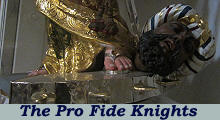 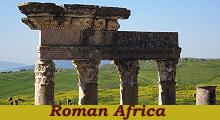 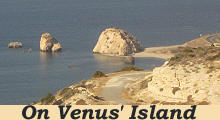
|